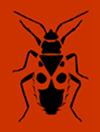Pelle and Tube contribute to the Toll pathway-dependent antimicrobial peptide production in the red flour beetle, Tribolium castaneum (Coleoptera: Tenebrionidae)
IF 1.2
3区 农林科学
Q2 Agricultural and Biological Sciences
引用次数: 2
Abstract
Insects are solely dependent on an innate immune system. Antimicrobial peptide production is the main immune response of insects. The molecular mechanisms underlying this reaction in Drosophila melanogaster involves the induction of antimicrobial peptide genes, which is regulated by the Toll and IMD pathways. The Toll pathway is mainly activated by fungi or Gram-positive bacteria and the IMD pathway by Gram-negative bacteria. In terms of comparative immunology, we investigated the antimicrobial peptide production system in the beetle, Tribolium castaneum, which differs from that in D. melanogaster. To obtain a more detailed understanding, we examined whether Pelle and Tube, orthologues of which in D. melanogaster are the Toll pathway components, contributed to antimicrobial peptide production and immune reactions. These two genes were not induced by challenges from any type of microbe, which in this case were Gram-positive bacteria, -negative bacteria and an eukaryote. Using Pelle and Tube knockdown pupae, it was demonstrated that Pelle and Tube are involved in the induction of Cec2 as a representative Toll pathway-dependent gene in T. castaneum by Gram-positive and -negative bacteria and eukaryote challenges. Furthermore, neither Pelle nor Tube contributed to immune defences against two entomopathogenic bacteria. These results, taken together with our previous fi ndings, led to the conclusion that the Toll pathway immune signaling reported in D. melanogaster indeed occurs in T. castaneum, and the gene sets involved in Toll signal transduction in T. castaneum did not differ signifi cantly from those in D. melanogaster, but transduced immune signals to challenges from Gram-positive bacteria, -negative bacteria and an eukaryote, which differed from those in D. melanogaster.红粉甲虫(Tribolium castaneum,鞘翅目:拟甲科)的小颗粒和管状体有助于Toll通路依赖性抗菌肽的产生。
昆虫完全依赖于先天免疫系统。抗菌肽的产生是昆虫的主要免疫反应。黑腹果蝇这种反应的分子机制涉及抗菌肽基因的诱导,该基因受Toll和IMD途径的调节。Toll途径主要由真菌或革兰氏阳性菌激活,IMD途径由革兰氏阴性菌激活。在比较免疫学方面,我们研究了与黑腹果蝇不同的赤拟谷Tribolium甲虫的抗菌肽生产系统。为了获得更详细的了解,我们检查了Pelle和Tube是否有助于抗菌肽的产生和免疫反应,Pelle和Tube在黑腹果蝇中的直系同源物是Toll通路的成分。这两个基因不是由任何类型的微生物的挑战诱导的,在这种情况下,这些微生物是革兰氏阳性菌、阴性菌和真核生物。利用Pelle和Tube敲除蛹,证明Pelle和Tube参与了革兰阳性菌和阴性菌以及真核生物挑战对作为Toll通路依赖性基因的Cec2的诱导。此外,Pelle和Tube都没有对两种昆虫致病菌的免疫防御做出贡献。这些结果,再加上我们之前的发现,得出的结论是,黑腹果蝇中报道的Toll通路免疫信号确实发生在灰腹果蝇中,并且灰腹果蝇参与Toll信号转导的基因集与黑腹果蝇没有显著差异,而是将免疫信号转导到革兰氏阳性菌的挑战中,-阴性细菌和一种真核生物,与黑腹果蝇不同。
本文章由计算机程序翻译,如有差异,请以英文原文为准。
求助全文
约1分钟内获得全文
求助全文
来源期刊
CiteScore
2.30
自引率
7.70%
发文量
43
审稿时长
6-12 weeks
期刊介绍:
EJE publishes original articles, reviews and points of view on all aspects of entomology. There are no restrictions on geographic region or taxon (Myriapoda, Chelicerata and terrestrial Crustacea included). Comprehensive studies and comparative/experimental approaches are preferred and the following types of manuscripts will usually be declined:
- Descriptive alpha-taxonomic studies unless the paper is markedly comprehensive/revisional taxonomically or regionally, and/or significantly improves our knowledge of comparative morphology, relationships or biogeography of the higher taxon concerned;
- Other purely or predominantly descriptive or enumerative papers [such as (ultra)structural and functional details, life tables, host records, distributional records and faunistic surveys, compiled checklists, etc.] unless they are exceptionally comprehensive or concern data or taxa of particular entomological (e.g., phylogenetic) interest;
- Papers evaluating the effect of chemicals (including pesticides, plant extracts, attractants or repellents, etc.), irradiation, pathogens, or dealing with other data of predominantly agro-economic impact without general entomological relevance.

 求助内容:
求助内容: 应助结果提醒方式:
应助结果提醒方式:


